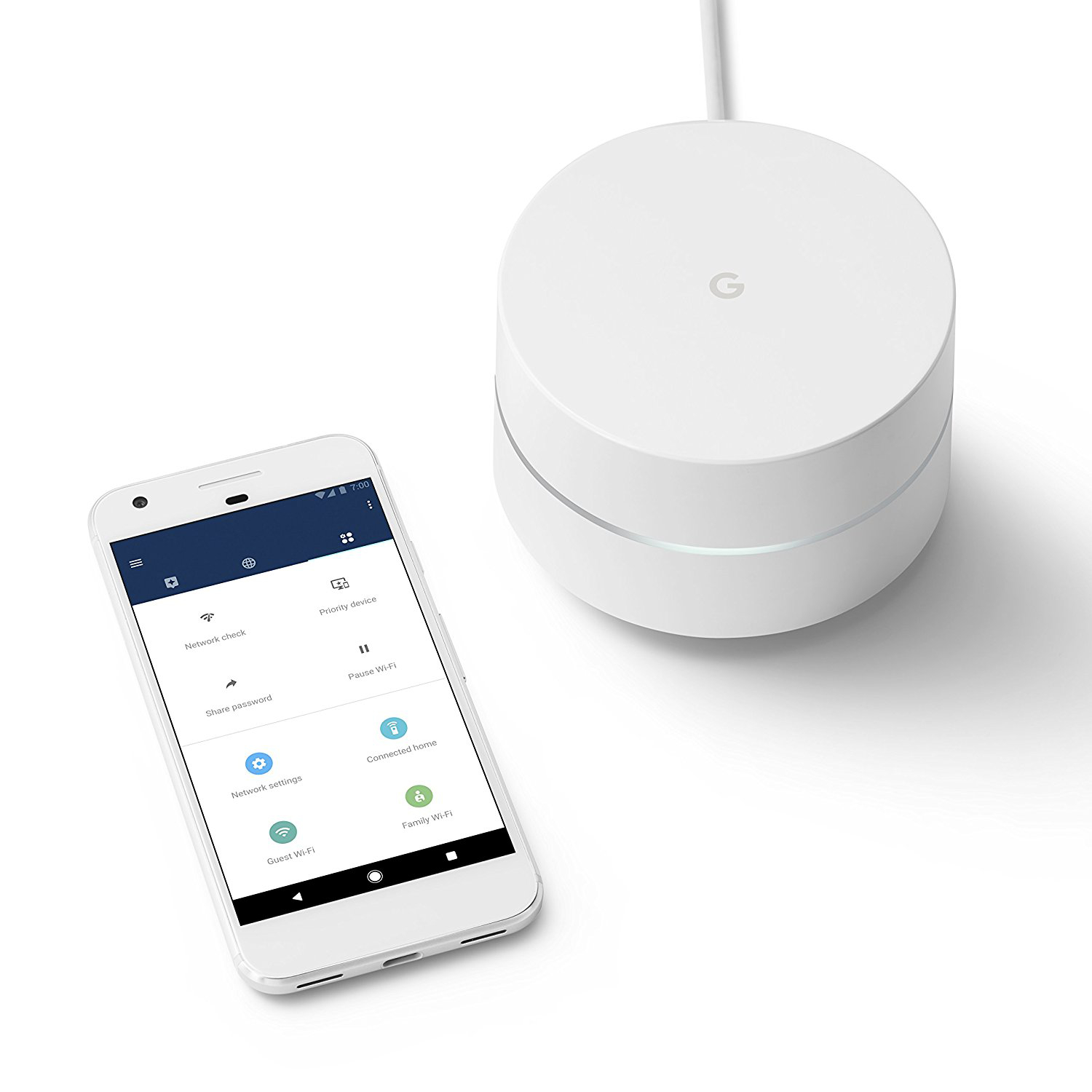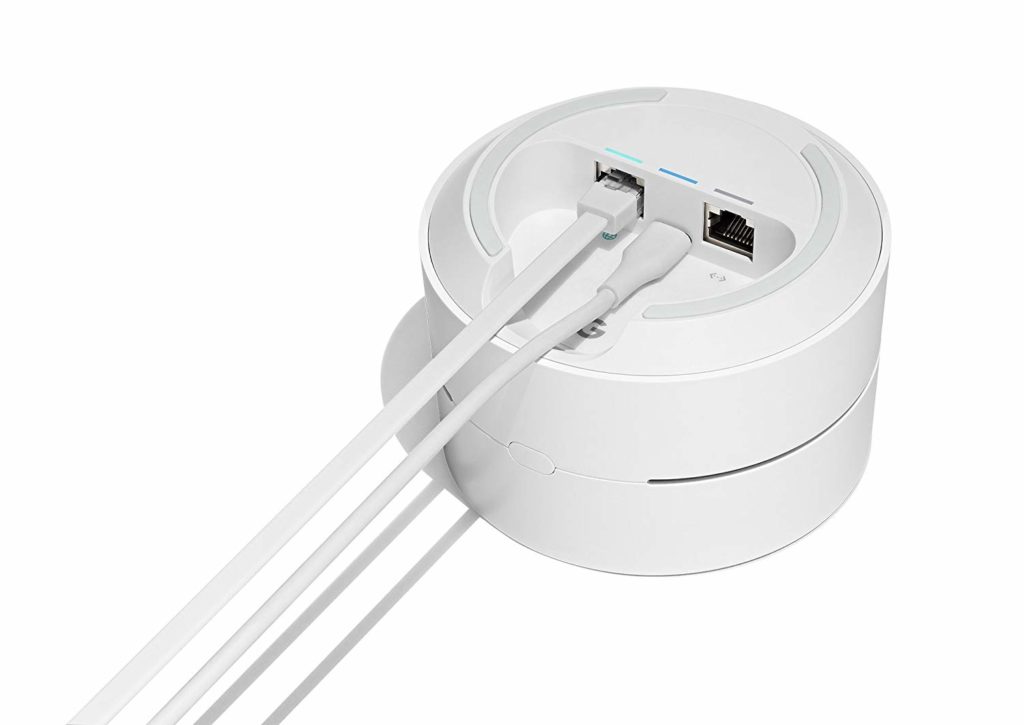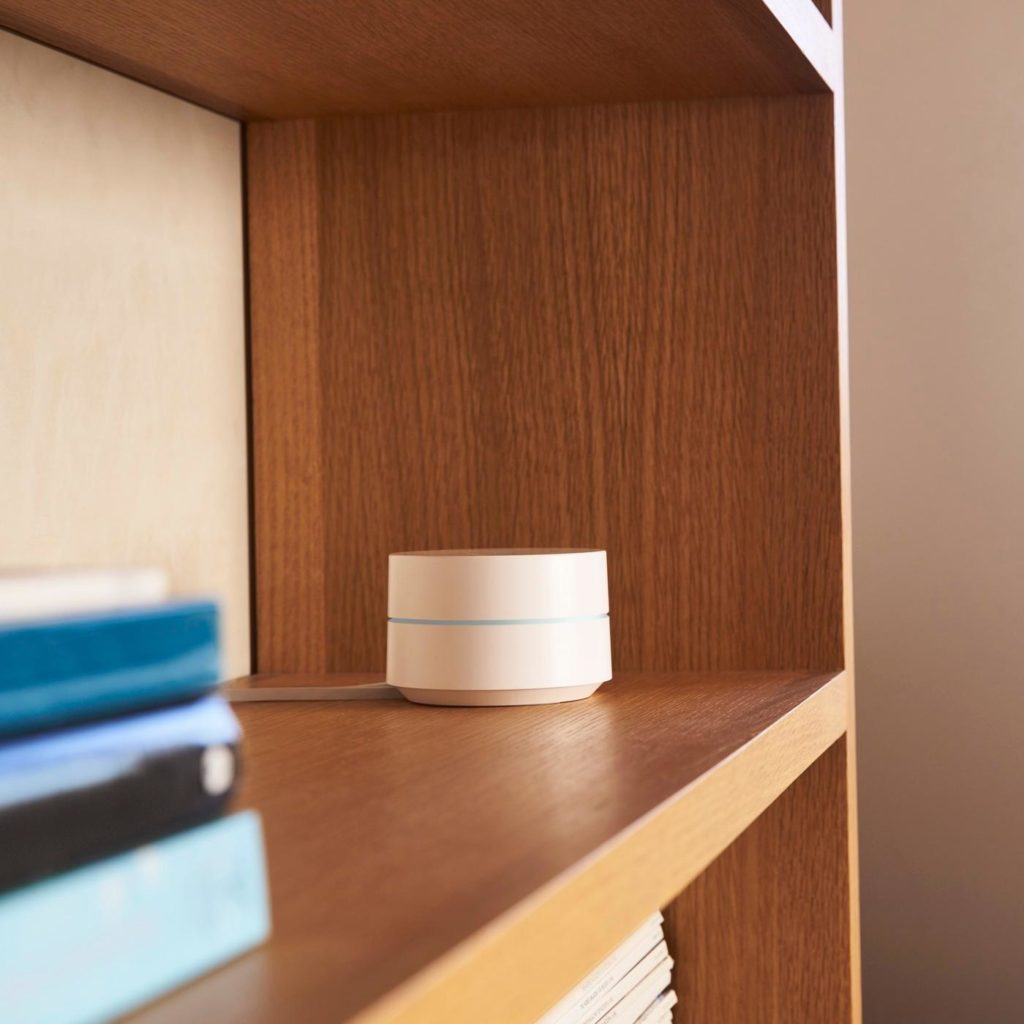Routers and range extenders may have become a thing of the past. New devices, such as Euro and the Netgear Orbi have brought consumers tri-band or Wi-Fi mesh systems, and Google has followed that trend with its Google Wi-Fi. It only makes sense for Google as it would compliment and improve their ever expanding smart-home collection. Google seems to have found the answer to creating the best mesh system yet, and right now, our Google Wi-Fi review is way ahead of competitors.
Design
- Minimalist puck shape with white LED band
- 1, 2 or 3 unit packs available
- 3 unit set covers up to 4500 square feet
- Simple set up
Google Wi-Fi can be purchased with one, two, or three units powered via USB-C, and each is a small, puck-like cylinder. It is designed very simply with a white LED band in the center. If you buy the set of three, it covers up to 4,500 square feet. One unit functions as the “router” of the system, while the others give off wired internet with Ethernet ports along with wireless internet. But all three are capable of the same functionality, so it doesn’t matter which
one is designated as the “router”.
To use it, all you need is the free app (available for iOS and Android). All you have to do is plug your “router” unit into your existing router via the Ethernet port, and use the app to scan the QR code on the Wi-Fi points connected to that unit. It gives you the name of your network and allows you to set a password. Then, just pair the other Wi-Fi points and label them in the app – in mere seconds, the “router” will recognize these Wi-Fi points and they will begin broadcasting.
App Features
- Keep track of network and devices connected
- Internet speed test
- Wi-Fi test
- Prioritize bandwidth
- Pause internet to certain devices
With Google Wi-Fi you will not have as much access as other devices, such as the Netgear Orbi. For example, you can’t control band switching as Google just handles it in the background for you. However, the app does allow you to keep track of all three units on your network along with all devices connected to it. There is an internet speed test included that allows you to carry out a mesh test to measure the health of the units’ connections, and a Wi-Fi test that measures connection strength from within the network. And, although you can’t control band switching, there is a feature that allows you to prioritize bandwidth to one device for a time and pause internet access to specific devices. Of course, the app also gives you control of your smart home devices, which makes it very easy – everything you need is in one place, on one app.
Hardware
- 802.11g/n/ac and AC1200 2×2 per unit
- Supports MU-MIMO, beamforming, and TPM
- No integrated modem
Each unit of our Google Wi-Fi review supports 802.11g/n/ac and up to AC1200 2×2, which is less than what is standard on routers. However, this doesn’t really matter unless you need a very high wireless speed – AC1200 can still support wireless speeds above 500 megabits, which is way more than most Internet connections. Support for MU-MIMO, beamforming, and TPM is also included in each unit along with two Gigabit Ethernet ports. Google Wi-Fi connects to your existing modem instead of replacing it, because it does not have an integrated modem. This connection uses up one of the Ethernet ports on the “router” unit, which again shouldn’t be a problem for most users as there are still free ports on the other units.
Performance
- Focuses on coverage over speed
- “Network assist” and “Gearing algorithm” used to find and switch devices to best signal
Google Wi-Fi seems to have everything you need, but how well does it work? As a mesh router system, it focuses more on coverage than having the fastest signal from a single location. Google uses “Network Assist”, which automatically finds and continuously monitors the best channel for your network, along with a “Gearing algorithm”, which automatically switches your connected devices to the strongest signal as you move around. This is where placement of the units comes in, and the app will also assist you in finding good placement. This is much better than traditional routers, because you will no longer have to manually change your Wi-Fi connection as you move around or have a weak signal at one area in your house.
Performance tests have come back very positive for Google Wi-Fi. It is not the fastest router, but gets some of the best coverage you can find, and is undeniably fast enough for most users. When tested against an AC1900 router (D-Link), the D-Link had a lot of trouble when moving to a different room if there was something in the way, such as a thick wall. In the other hand, Google Wi-Fi had no trouble just switching to the nearest unit and keeping even coverage. One problem to note is that it was sometimes slow to switch the device’s connection to the right point, but this is a minor issue and can be improved.
Pricing and Availability
For a minimalist mesh router, Google Wi-Fi is the best you can get right now. However, larger mesh routers (such as Netgear Orbi) are faster and better when it comes to performance, but are also much more expensive. If you are looking for something affordable and also very capable, look no farther than Google Wi-Fi – it will get the job done with no problem. A single unit costs $129 and the three units cost $289, which is far less than the Euro pack (also minimalist), and Netgear Orbi. It will provide full house Wi-Fi coverage at a speed good enough for most users.
Summary
7.8 tech score







